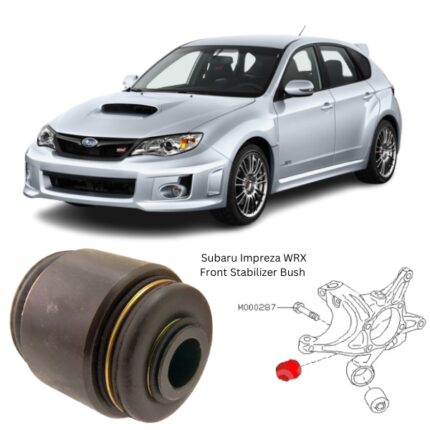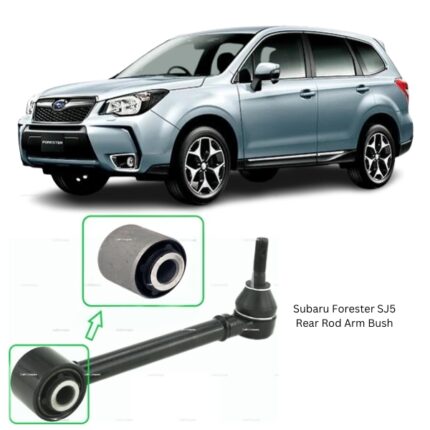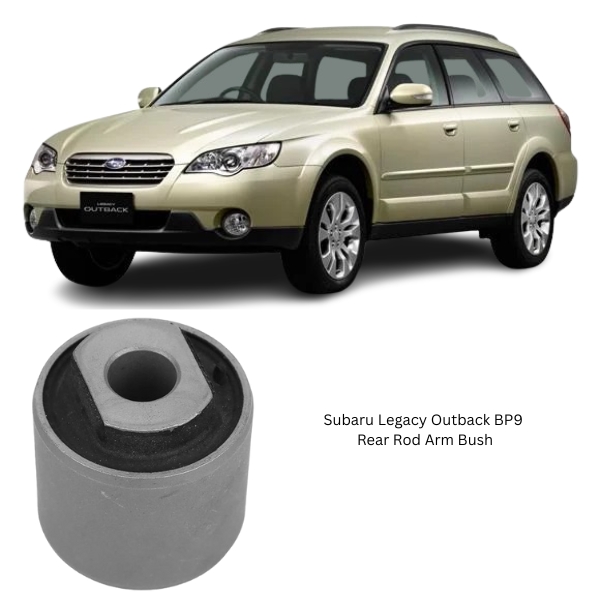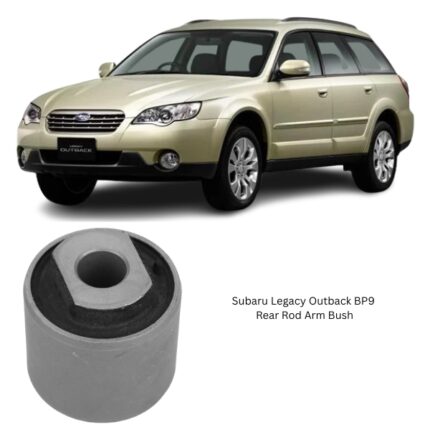Get Subaru Legacy Outback BP9 Rear Rod Arm Bush 20250-AE000B in Kenya
The rear rod arm bush, also referred to as a rear control arm bushing, is a critical suspension component found in the rear axle assembly of a vehicle. It plays a central role in connecting the rear rod arm (also known as the trailing arm or control rod) to the vehicle’s chassis or subframe. This bush absorbs road shocks, reduces vibrations, and maintains proper wheel alignment during various driving conditions.
Though it appears as a compact cylindrical or oval-shaped part made of rubber or polyurethane and sometimes metal, its function directly impacts ride comfort, stability, tire wear, and suspension durability.
1. Purpose and Function of the Rear Rod Arm Bush
The rear rod arm is designed to guide the up-and-down movement of the rear wheels while resisting forward and backward motion. The rear rod arm bush acts as a flexible joint between the rod arm and the frame, allowing limited motion while absorbing stress and vibration. This cushioning effect is crucial for:
-
Dampening road shocks and vibrations before they reach the passenger cabin.
-
Maintaining rear wheel alignment, especially under braking and acceleration.
-
Allowing controlled movement between suspension and chassis components.
-
Enhancing handling stability by reducing excessive play in the rear suspension.
-
Minimizing noise and harshness caused by direct metal-to-metal contact.
The bush allows the rear control arm to pivot slightly, ensuring proper movement without transmitting stress to the rigid frame.
2. Design and Construction
Rear rod arm bushes are engineered to balance durability, flexibility, and load-bearing capacity. A standard bushing consists of the following parts:
-
Outer metal shell: Press-fit into the control arm or subframe bracket.
-
Inner metal sleeve: Attached to the mounting bolt.
-
Elastomeric core (usually rubber or polyurethane): Bonds the outer and inner sleeves while providing flexibility.
The elastomer material is designed to withstand high loads, resist environmental damage (such as oil, heat, and ozone), and absorb both vertical and lateral forces.
3. Materials Used
The materials used in rear rod arm bushes vary depending on vehicle type and intended performance:
a) Natural or Synthetic Rubber
-
Offers superior vibration absorption.
-
Commonly used in passenger vehicles for comfort-oriented suspension.
-
Affordable and quiet.
b) Polyurethane (PU)
-
Firmer and longer-lasting than rubber.
-
Ideal for performance or heavy-duty vehicles.
-
Resists deformation under load and offers enhanced steering response.
c) Hydraulic Bushings
-
Found in some modern vehicles.
-
Filled with a damping fluid that further reduces vibration and enhances isolation from road harshness.
Each material has unique properties to meet vehicle-specific comfort and handling needs.
4. Location and Configuration
The rear rod arm bush is mounted at either end of the rear control arm (also called trailing arms, upper/lower arms, or toe links depending on suspension geometry). The most common configuration involves two bushes per control arm—one connecting to the chassis/subframe and another connecting to the wheel hub or knuckle.
RH (Right Hand) and LH (Left Hand) bushes are often mirror images of each other to match the geometry of the suspension and the forces they experience during cornering, braking, and acceleration.
5. Operation During Driving
As the vehicle moves over bumps or through curves:
-
The control arms pivot slightly, guided by the flexible movement of the bushes.
-
Longitudinal forces from braking or accelerating are absorbed by the bush, which cushions and limits backward and forward movement.
-
Lateral forces during cornering are also absorbed, helping the wheels maintain alignment with minimal deflection.
The effectiveness of these bushes ensures smooth, controlled suspension motion and reduces stress on rigid suspension components.
6. Symptoms of a Worn Rear Rod Arm Bush
Over time, rear rod arm bushes deteriorate due to repeated flexing, exposure to heat, water, dirt, and chemicals like oil or road salts. A failing bush compromises ride comfort, tire wear, and overall vehicle control. Common signs include:
a) Clunking or Knocking Noises
-
Especially when driving over bumps or making turns.
-
Indicates excess movement due to worn-out bushing material.
b) Poor Rear-End Stability
-
The vehicle may feel “loose” or unstable, especially at high speeds or under braking.
c) Uneven or Rapid Tire Wear
-
Poor alignment control leads to misaligned rear wheels.
d) Rear Wheel Misalignment
-
Measurable during a suspension inspection or wheel alignment check.
e) Excessive Vibration
-
Felt in the cabin, especially when going over rough surfaces.
Ignoring these symptoms can result in damage to nearby components, reduced suspension lifespan, and safety concerns.
7. Inspection and Diagnosis
Routine suspension checks during service or when diagnosing noises or instability often include:
-
Visual inspection for cracks, deformation, or missing material.
-
Pry bar testing: Applying force to the arm to check for excessive movement at the bush.
-
Bushing movement while the vehicle is raised and rear wheels are free.
If the bush appears torn, cracked, or overly soft—or if the arm shifts more than expected—it’s time for a replacement.
8. Replacement Procedure
Though not as fast as bolt-on parts, replacing the rear rod arm bush is manageable with proper tools. Steps generally include:
-
Lift and secure the vehicle safely.
-
Remove the affected control arm from the suspension assembly.
-
Press out the old bush using a hydraulic press or bushing removal tool.
-
Clean the housing of old residue or corrosion.
-
Press in the new bush, ensuring proper orientation.
-
Reinstall the control arm, torqueing all bolts to specification.
In some cases, replacing the entire rod arm with pre-installed bushes may be quicker or more cost-effective. A wheel alignment is usually recommended after the replacement to ensure proper geometry.
9. Preventive Maintenance and Lifespan
While rear rod arm bushes are built for durability, they do not last forever. Factors affecting their lifespan include:
-
Driving Conditions: Rough terrain, potholes, and aggressive driving accelerate wear.
-
Environment: Heat, road salt, and oil contamination can degrade rubber.
-
Load Stress: Vehicles that carry heavy loads or tow trailers experience more bushing stress.
Preventive tips:
-
Inspect during every major service or suspension check.
-
Replace in pairs (RH and LH) to maintain balance.
-
Avoid driving with failed bushes to prevent collateral damage.
Typical service life is between 80,000–150,000 kilometers, depending on use.
10. Role in Ride Comfort and Safety
The rear rod arm bush directly influences:
-
Comfort: By isolating vibrations and jolts from road imperfections.
-
Handling: Maintains proper rear suspension alignment for predictable behavior during turns.
-
Safety: Ensures the rear wheels stay firmly planted and aligned under all conditions.
-
Durability: Protects control arms and chassis mounting points from premature wear or breakage.
In essence, it bridges the gap between flexibility and control, allowing for dynamic suspension movement without compromising structural stability.
Follow us on Facebook for more parts.





Reviews
Clear filtersThere are no reviews yet.